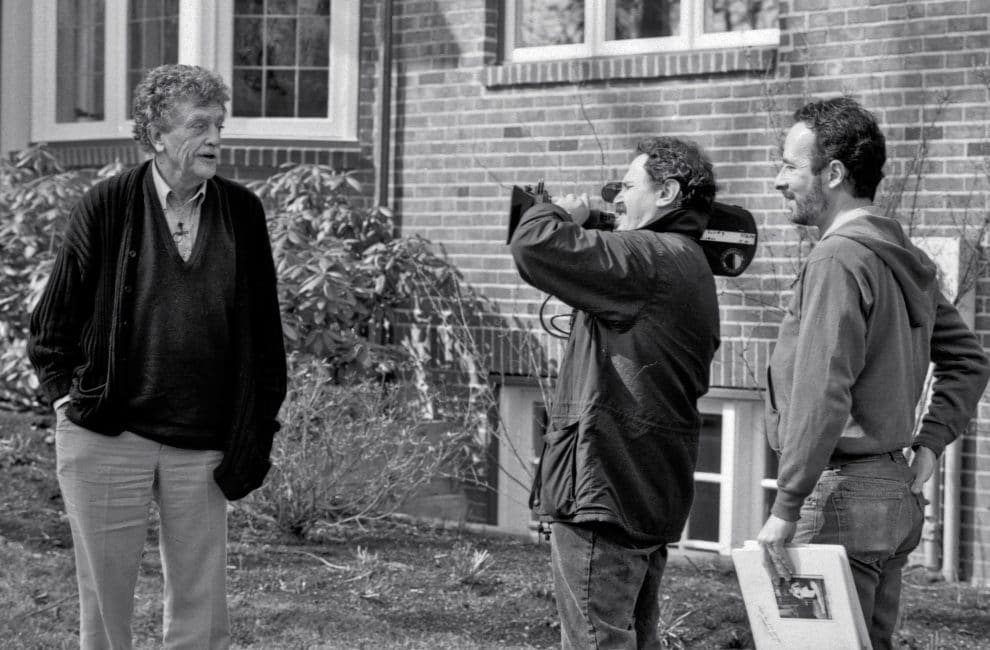
Kurt Vonnegut is interviewed by Robert Weide outside the famed writer's boyhood home in Indianapolis. ©B Plus Prods/C. Minnick
Robert Weide On His New Vonnegut Documentary
While digging through a box of Kurt Vonnegut’s papers at IU’s Lilly Library a few years ago, Robert Weide made an unexpected discovery: a 1982 letter from a fan who wanted to make a documentary about the famed writer. Weide immediately recognized the signature. It was his own.
That long-ago letter sparked a project that has lasted until just recently, when Weide completed Kurt Vonnegut: Unstuck in Time. It reaches movie screens November 19, with Hulu to follow. We caught up with the filmmaker, whose credits include directing the first five seasons of HBO’s Curb Your Enthusiasm. The following conversation has been edited for space and clarity.
What was your first meeting with Vonnegut like?
I was 22 and very nervous. He said, “Come on over,” and I did. He poured me probably the first scotch I ever had. He was very polite and friendly, and that made it easy. Even though I didn’t start filming for another six years, whenever I was in New York, we’d get together and go for a stroll around the Upper East Side. On a couple of occasions, he came out to L.A. And each time we logged face time, it advanced the warmness and friendliness. Filming in Indiana in 1994 was a big step. We drove back to New York from Indiana together, laughing, listening to the radio, and being silly.
When did you decide that this would be, in part, a documentary about the making of the documentary?
I was initially very resistant to bringing that meta element into the film, primarily because I didn’t need to see my mug up there and didn’t want to come off as egotistical. But as the years turned to decades and he and I became closer friends, it seemed dishonest not to. I was worried about journalistic integrity, but integrity would have been breached by not disclosing it.

As Weide filmed at Vonnegut’s childhood home on Illinois Street, he came to understand the author’s complicated relationship with Indy.©B Plus Prods/C. Minnick
So you brought in a co-director.
I never had a co-director on a project before, but I thought, If I’m going to be on camera, I want somebody else to tell that part of the story. And, in practical terms, who’s asking me the questions? Don Argott and I met at a film festival in Kiev. A couple of months later, I said, “I don’t know if we discussed this, but are you a Kurt Vonnegut fan?” He was. So he filmed interviews with me and we started to travel together. His strength is verité, mine is documentary profiles.
Those pair up well in the final film. Why did it take so long to finish?
I never had any financing. It was on and off during all of those years. The financing was always out of my own pocket when I had a little extra money or time. I usually only had one or the other. When I had money, it meant I was working. When I had time, it meant I wasn’t working. The next thing you know, 40 years go by.
The technology you used must have changed in that time.
The early shoots were on 16mm and edited on a tape-to-tape system. By the time things really got active, after the 2014 Kickstarter campaign to finish the documentary, everything was digital.
In the film, Vonnegut is often laughing. How important was it to you to show him having fun?
It wasn’t a deliberate choice. That was just who he was. Anyone who knew him will always talk about his laugh. And he loved comedy. One of those pinch-me moments was when he asked me what I considered the best Marx Brothers film. I said, “Probably pound for pound, Duck Soup.” So we went to the local video store and picked it up and watched it, both laughing like children.
I think you hit something early in the film when it brings up how Vonnegut made literature fun even when dealing with incredibly serious issues. Was that easy access critical to his success?
There were so many people who normally considered reading a chore who would come across Vonnegut and think, Wow, this goes down easy. Serious literature—spinach literature—that’s supposed to be good for us can be intimidating. There’s nothing intimidating about Vonnegut. That’s why some critics don’t take him seriously. But, boy, those books still sell. Every generation rediscovers him.

Vonnegut’s friendship with Weide became so close that the director felt he had to cover it in the film.©B Plus Prods/C. Minnick
You also made documentaries on Mort Sahl, Lenny Bruce, and others. How does Vonnegut fit with those?
I always loved comedy, whether that’s movies, standup, or literature. When I read Breakfast of Champions, I found my Vonnegut gateway drug. I went out and read everything by him. I bought his books. I looked up magazine articles at the library. It’s kind of a cliché, but he’ll make you laugh one minute and cry the next. Lenny Bruce was a comedian, but he dealt with death and other serious issues. I was always attracted to that mix—covering serious personal, social, and political issues, and bringing humor to it.
The early part of the film is a love story. His first wife, Jane, was integral to his writing and his success. But then Vonnegut leaves her. Rather than play down or ignore that chapter of his life, you go deep. Was it a challenge incorporating material about that part of his life into the film?
I never felt like it was anything I would duck around. It was part of his biography. His daughter, Edie, recently published his love letters to Jane. They were so over the top, if she had gotten a restraining order, it would not have surprised me. Really syrupy, passionate love letters. She was his biggest cheerleader, ordering books under false names, writing letters to magazine editors. She was responsible for so much of his career. Then, with Slaughterhouse-Five, he became wealthy and famous, and the next year he leaves her for a much younger woman. It’s the old story. I had a cut of the film where, at early screenings, a very consistent question was, “What happened to Jane?” They wanted to know if she was OK. So I found an interview where the kids talked about her, and it gave some closure.
That wasn’t Vonnegut’s only shortcoming.
Yes, he had a somewhat manic element and was prone to depression. I saw that side of him, too. Some of that was genetic. Some was his home situation. It wasn’t particularly pleasant there at the time. And he could take very personally what was happening in the world—not just politics, but also environmental devastation. He was a canary in a coal mine on that issue.
When you visited Indiana with him, what places and people seemed to have the strongest impact on him?
He got a big kick out of seeing his old family home on Illinois Street and walking through it. He had only visited it once over the past several decades, and he would have been too shy to knock. But, with me, he had the perfect excuse. There’s a pond in the backyard with a sculpture of a frog that spits water. When he saw that, the first thing he said was, “I seem to recall it being much larger than this.” He was touched that the various owners had kept his handprints on the banisters. And that the person who later bought the house was the famous architect Evans Woollen. He said his father would have been very proud that an architect bought the house. Vonnegut also loved seeing the family cottage at Lake Maxinkuckee. It was sold during or just after World War II, and he wanted to take Jane there on his honeymoon. The owner of the house was apparently a romantic man and allowed them to use it.
Did he share any memories from his youth there?
There’s the Tralfamadore origin story. [Tralfamadore is the otherworldly location where the main character of Slaughterhouse-Five is transported.] Kurt said that the youngest is always the comedian. All you can do to get noticed is make a joke or a pun or a noise. At the Maxinkuckee home, there’s a platform that goes out into the water. His cousins, aunts, and uncles would all gather there and hang out. His cousin Richard was pointing out the constellations and planets—“There’s Orion. There’s Andromeda. There’s Saturn.” Kurt, who was 10 at the time, pointed to the sky and said, “And there’s Tralfamadore!” He told me that on the spot where it happened.
You also followed him back to Shortridge High School.
He boasted that it was a great school—better than any college or university he later went to. He said that picking out classes there was like going through a toy store catalog. His introduction to writing was reporting for The Daily Echo, the student newspaper his parents had also worked on. He said he still kept a lot of those journalism rules in his fiction: “I tell you the important stuff up front.”

Vonnegut often bragged about Shortridge High School, where he learned to write at the student newspaper.©B Plus Prods/C. Minnick
Documentaries about writers can be tough. How do you show writing besides a person at a typewriter? But Vonnegut—like Mark Twain—was also a star on the lecture circuit. Do you think he enjoyed performing?
I think it was important to him to connect to an audience. Writing books, you are putting it out there and never hear an audience’s reaction. He enjoyed lecturing, but it did get to a point where it felt like a drag—the traveling and the hotels and airports. He would always say this was his last time out. Toward the end, it became harder to find what was funny. He hated that we had destroyed this lovely planet and was depressed about the Bush administration. He would have lost his mind when Trump was elected.
Your film version of Mother Night (Weide wrote the screenplay and produced) came after Slapstick of Another Kind and before Breakfast of Champions, two films that barely got released. Mother Night got a better response, but it still seems like adapting Vonnegut for film is a major challenge. What was your approach and was he involved in that film at all?
He gave me the rights on a handshake. Our deal was a 50/50 split. Give me the rights for free, and the day I get a check is the day you will get a check. When I got my first check, he got his. He was very supportive. I would send him pages along the way, and sometimes I would take his advice and sometimes I didn’t. He said, “The book is my book and the screenplay is your screenplay. Think of my book as the friendly ghost hanging around the house. Refer to it and ignore it if you want.” I asked, “If you were writing the book or screenplay now, is there something you would include that’s not in the original?” He gave me a couple of jokes that I reworked and included, and an idea for a scene that was kind of awful. He said, “I never wrote books to be turned into movies. Now all of the top-selling writers are writing books with the idea of them being adapted into films. Most of mine won’t make good ones.”
What did he think of the film version of Mother Night?
He came to the premiere, and, in the opening moments, he was chuckling. That’s the only review I needed.
His hometown has certainly embraced him recently. What were his feelings toward Indianapolis, and did those change over time?
It was like a lover’s spat. Both think the other is mad at them. He felt the city didn’t like him and the city felt he didn’t care for them, that he was mocking them. But he was very nostalgic and stayed in touch with his childhood friends. He made an analogy that Indianapolis is like a martini. There’s the sweet and the bitter. It has historical moments of great liberalism and, at the same time, a reactionary element, too. Some of Indy’s antagonism toward Vonnegut was very simple: They didn’t like the dirty words in his books.
You have boxes and boxes of material on Vonnegut, including home movies. A lot of it didn’t make it into the film. It would be a full-time job to chronicle all of that. Where will that stuff eventually be housed?
I haven’t thought about it. At some point, I will. There is a lot. Kurt was always a manual typewriter guy, so what you have are these pages he typed, with coffee stains, crossed-out words, margin notes, arrows, revisions. You can say this is how such-and-such became such-and-such. You can track all of that, which, for me, is thrilling. Now writers just cut and paste, and all we have is pages printed from a computer. Tracking the evolution is gone.
Were you aware that Vonnegut was mentioning you in his final novel Timequake, or did that revelation happen as you were reading the book?
I remember reading it in bed and I let out a holler. I must have woken up the neighbors. It was a thrill.
What’s next for you?
I’ve spent two-thirds of my life on this thing, so I have no idea what my life will feel like when the film is finally behind me.





